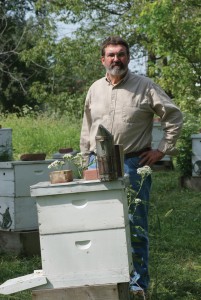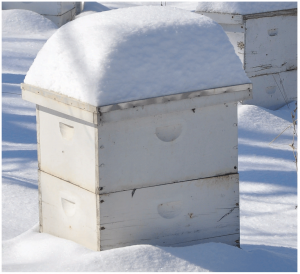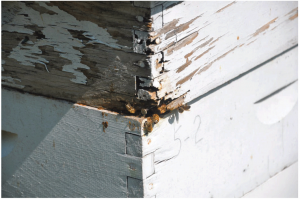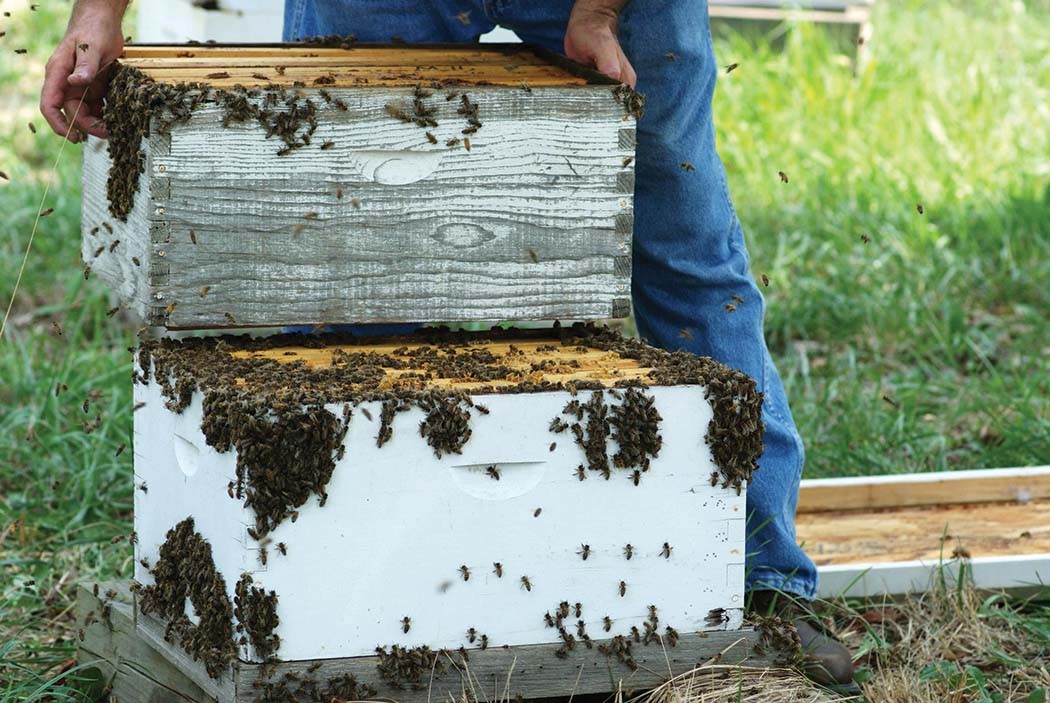 Got A Question? He Knows!
Got A Question? He Knows!
Send your questions to Phil at
phil@philcrafthivecraft.com
http://www.philcrafthivecraft.com
Q: A nature lover in Kentucky writes:
Here’s something I wonder: since honey bees are an invasive species and nature in our part of the world probably did just fine before they came, how long would it take for the other pollinators to fill that biological niche if honey bees all went away?
A: That is an interesting question, and my short answer, as it pertains to the natural world, is not long.
To begin with, though honey bees are not indigenous to the Americas, I would refer to them as non-native rather than invasive. What is the difference? I found the following United States Department of Agriculture Definition at a Nature Conservancy webpage “. . . an alien (or non-native) species whose introduction does, or is likely to cause economic or environmental harm or harm to human health.” Relationships among organisms in an ecosystem are complicated and never completely understood, but over the last few centuries, honey bees have become well integrated into our biological landscape. Though some argue that they pollinate invasive plant species which native pollinators ignore and rob nectar from some native plants without effectively pollinating them, they have not displaced native bees. We hear much discussion these days about threats to native pollinators from habitat loss, monoculture crops, and pesticides, but competition from honey bees is not on the list. Moreover, they are the primary or only pollinators of many agricultural products which enrich our diet. Most people would agree that their net impact on our environment is beneficial.
In considering the effect of a loss of honey bees in our natural landscape, we have two historical examples to judge from. First, as you note, they are not native to this part of the world, and there was a thriving ecosystem here before they were a part of it. A more recent demonstration occurred in the late 1980s when Varroa and tracheal mites first made their appearance in this country. They attacked both the bees in our apiaries and those in the wild – feral or, as I prefer to call them, unmanaged colonies – with devastating results. Researchers quickly came up with methods to control, though not eradicate, mites in our hives. After an initial sharp decline, the number of number of managed colonies stabilized and has begun to increase in recent years, but mites in wild colonies proliferated unchecked. The number of unmanaged colonies plummeted. How low? No one really knows, but by the time I became Kentucky State Apiarist in 1999, I was telling beekeepers that wild bees were essentially extinct. There were still bee trees in the woods, to be sure, where uncaptured swarms from beekeepers’ hives would take up residence, but they brought their parasites with them: Varroa and, in the early days, tracheal mites as well. The unmanaged colonies could not thrive and, within a year or so, they would succumb and die out, like bees in managed but untreated hives. The best nesting sites would be repopulated by other escaping swarms, but there was no sustainable wild population of honey bees.
This is a complete reversal of the world which existed before mites. Beginning beekeeping books written before the 1980s recommend capturing swarms from wild colonies as a reliable and inexpensive way of acquiring bees. In those days anyone interested in becoming a beekeeper could just spread the word to his or her neighbors to call if they saw a swarm. Unmanaged colonies were so plentiful that it never took long to find one. After the mite invasions, this method of acquiring bees disappeared from beekeeping manuals. People my age who grew up in rural or suburban areas in the decades before mites remember not being able to run across the yard without the risk of being stung by a honey bee working the clover among the grass. (Few of us wore shoes in the summertime back then.) The bees that stung us in those days were mostly from wild colonies. Nowadays it’s rare to see a honey bee in yard or garden unless you have a neighbor with hives. The current status of unmanaged colonies is unclear. Some beekeepers feel that we are seeing more bee trees recently, and speculate that they house wild colonies which have developed some Varroa resistance. I am not convinced. We have also seen a great increase in the number of backyard beekeepers in the last few years, in both rural and urban landscapes, and their hives are sending additional swarms out every year. Some of these are captured, and re-installed into hives, but many end up in the trees, at least temporarily.
Whatever the population of wild bees is now, the fact is for several decades they were virtually non-existent, and the effect on native flora was – negligible. There are over 3,500 species of indigenous bees in North America, not to mention other native pollinators, and these do the lion’s share of the pollination work in nature. They even perform some agricultural pollination as well, especially in small gardens and orchards. My mother maintained a large garden in Eastern KY, both pre-Varroa and after. It never lacked pollinators, though there were no beekeepers near her, and I rarely saw honey bees there post-mites.
Commercial agriculture is a completely different story. Almonds, apples, melons, cranberries, and many others, would not be productive without large numbers of honey bees to pollinate them. Modern American agriculture has achieved remarkable efficiency by cultivating thousands of acres of single crops. It is impossible for native species to pollinate a crop such as almonds, which bloom for only a few weeks, when nothing but almond trees grow for miles around and there is no other food source to sustain the bees through the rest of the year. Only honey bees, which live in large colonies, adapt to man-made hives, and can be transported by the tractor trailer load, are capable of pollinating today’s monoculture crops. That doesn’t mean that we would starve without them. Grains, such as wheat, rice, corn, and oats, are pollinated by wind. Many crops self-pollinate, like beans, peas, and tomatoes. Others are important to us, not for their fruit, but for their leaves, roots, or flowers, all of which are produced whether or not the plant is pollinated. Think, lettuce, spinach, potatoes, carrots, and broccoli. If honey bees were to disappear, some of our favorite foods would be less available and much more expensive, but we would not go hungry.
However, I do not think that we need to worry about honey bees going away. Though beekeepers continue to lose too many colonies each year, they also continue to replace their losses by dividing colonies and making nucs. We have always done this. According to the USDA Agricultural Statistics Service, the number of managed colonies has actually risen in recent years – not a great deal – but definitely not a decrease. That doesn’t mean that life is easy for beekeepers. Whereas I do not worry about the extinction of honey bees, I do worry about the future of beekeepers, especially commercial apiaries. While colony losses continue in the 40% range every year, it is difficult for large beekeepers to stay in business. Without them, the beekeeping supply companies would be in trouble, and that would affect small beekeepers as well. I also worry about native pollinator species. Native bees, butterflies, etc. are threatened by some of the same factors which are stressing honey bees: habitat loss, monoculture crops, and pesticides. The question is not whether native pollinators can replace honey bees in nature, but what can we do about the loss of native pollinators?
Q: A beekeeper in New York writes:
The weather’s been mild here in central NY, with today’s temperature 60° and scattered showers at the bee yard. I’ve had the mouse guard in place for about a week (galvanized piece of corner bead with 10-3/8” holes drilled into it). I opened the hive today, and I was surprised to find the inner cover dripping with moisture. Being that there was an upper and lower entrance to the hive I thought it would have ventilated this moisture out. I was just wondering if you can shed some light on the cause and prevention. The hive sits on top of three wooden pallets so it isn’t buried in weeds that might block the entrance.
 A: You are quite right to be concerned about good hive ventilation. Most beekeepers recognize the need for it in warm or hot weather, but it isn’t upper most in their minds once cool nights begin to remind us that winter is on its way. New beekeepers who live up north are especially quick to worry about the cold (I live in Kentucky where the winters are much milder.), and their impulse is to seal all the gaps and holes in their hives, just as they do in their homes, to eliminate drafts. Isn’t duct tape great stuff? Yes, we don’t want our bees to be cold, but we also don’t want them spending the winter in a damp hive. How warm do you feel wearing a wet wool sweater? If a hive is too well sealed, moisture is trapped inside. You saw the evidence of that in the condensation on your inner cover. I suppose people tend not to think of humidity as a Winter issue because conventional heating systems in our homes have the opposite effect. They dry the air to the point that we sometimes have to use humidifiers in order to be more comfortable.
A: You are quite right to be concerned about good hive ventilation. Most beekeepers recognize the need for it in warm or hot weather, but it isn’t upper most in their minds once cool nights begin to remind us that winter is on its way. New beekeepers who live up north are especially quick to worry about the cold (I live in Kentucky where the winters are much milder.), and their impulse is to seal all the gaps and holes in their hives, just as they do in their homes, to eliminate drafts. Isn’t duct tape great stuff? Yes, we don’t want our bees to be cold, but we also don’t want them spending the winter in a damp hive. How warm do you feel wearing a wet wool sweater? If a hive is too well sealed, moisture is trapped inside. You saw the evidence of that in the condensation on your inner cover. I suppose people tend not to think of humidity as a Winter issue because conventional heating systems in our homes have the opposite effect. They dry the air to the point that we sometimes have to use humidifiers in order to be more comfortable.
Of course bees have a source of central heat: their own bodies. They crowd together in a tight cluster when temperatures drop into the 40s(°F) or below, and flex their wing muscles to warm themselves and add heat to the cluster. They can maintain a temperature inside the cluster of between 85 to 95°F even when the outside thermometer reads below zero. In fact, bees are so efficient at creating their own warmth that, in most places, a healthy colony has no problem dealing with very cold weather without any aid from beekeepers. All they need is fuel in the form of honey to power their metabolisms. But heat isn’t all they produce. Bees also breathe, and produce moisture that needs an outlet. There’s an analogy I like to use. The University of Kentucky (Did I mention that I live in Kentucky?) plays basketball in a huge arena, which can hold more than 24,000 people on game nights. A couple of years ago, there was an article in the local paper which said that it has to get close to 40° outside before the staff at Rupp turns on the heat. All those bodies, packed tightly together and yelling (because the Wildcats usually give them a lot to cheer about) generate plenty of warmth. However, the arena has to run ventilation fans to disperse the humidity from all that perspiring and respiring humanity. It’s very much like a winter cluster, except the bees do it more efficiently and they don’t need a clear line of sight to watch the game.
 Many northern beekeepers, like you, add a second entrance near the top of the hive during Winter. In cold climates, there is always a risk that snow and ice will accumulate enough to completely block the lower one. If it were also the only one, the problem of ventilation would become extremely serious. With both entrances open, as they are now in your hive, it would seem reasonable to assume that they would create a nice flow of air which would take care of the moisture issue. However, it obviously is not doing that, and the problem may get worse later on when you have a foot of snow around your hive. I don’t use upper entrances myself, even in the Winter. Snow accumulations here are rarer, shallower, and briefer than in the north. Also my old boxes have plenty of cracks and holes for air to move through. What I do is to elevate one end of the outer covers of my hives to allow better air flow. I accomplish this by placing a small stick, about ¼” thick and an inch or two long (length really does not matter) on top of the inner cover, and under the outer cover. I use these props year around. In Winter the air movement keeps my bees from becoming damp and chilled in the cluster, and during the rest of the year it carries away some of the excess water in ripening honey. If moisture problems persist, the outer cover can always be temporarily propped a little higher.
Many northern beekeepers, like you, add a second entrance near the top of the hive during Winter. In cold climates, there is always a risk that snow and ice will accumulate enough to completely block the lower one. If it were also the only one, the problem of ventilation would become extremely serious. With both entrances open, as they are now in your hive, it would seem reasonable to assume that they would create a nice flow of air which would take care of the moisture issue. However, it obviously is not doing that, and the problem may get worse later on when you have a foot of snow around your hive. I don’t use upper entrances myself, even in the Winter. Snow accumulations here are rarer, shallower, and briefer than in the north. Also my old boxes have plenty of cracks and holes for air to move through. What I do is to elevate one end of the outer covers of my hives to allow better air flow. I accomplish this by placing a small stick, about ¼” thick and an inch or two long (length really does not matter) on top of the inner cover, and under the outer cover. I use these props year around. In Winter the air movement keeps my bees from becoming damp and chilled in the cluster, and during the rest of the year it carries away some of the excess water in ripening honey. If moisture problems persist, the outer cover can always be temporarily propped a little higher.
Don’t worry about providing too much ventilation. Honey bees’ natural nesting sites are hollow trees, which are even draftier than most of my old equipment. After all, if the cavities didn’t have openings, the bees wouldn’t have access to them. Whether in boxes or trees, bees have a sealant for plugging holes and eliminating excessive air flow. It works even better than duct tape, as any beekeeper knows who has struggled to pry apart boxes in a hive he hasn’t checked in a while. Propolis is produced from plant rosins collected by foragers. It can plug holes, seal cracks, and even block openings in inner covers and entrances. We aren’t raising carpenter bees here. They aren’t capable of drilling their own holes, but by using and removing propolis around existing openings, they are able to exercise a great deal of interior climate control. (There may be more to propolis than plugging holes. Bees have been known to line the inside of a nesting site with it, creating a propolis envelope around the cluster. Recent research at the University of Minnesota has shown that the presence of this envelope is beneficial to colony health.)
I can’t answer the question of why your upper and lower entrances are not providing sufficient ventilation in your hive – perhaps some combination of rain, entrance reducers, and still mild weather. In any case, I think preventing the problem is as easy as using a few small sticks to prop up one end of your outer cover. Hoping for a mild Winter wouldn’t hurt either.









